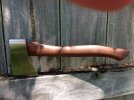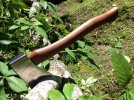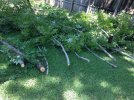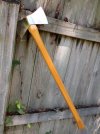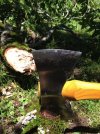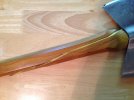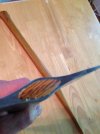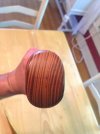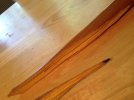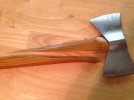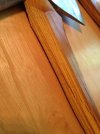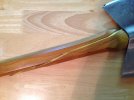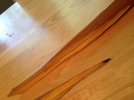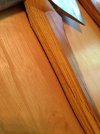Pecan tree in back yard let go of another big branch, time to clean up. Instead of breaking out the Stihl, I decided to do this one the old fashioned way and use a couple of my Reeves axes. The belt axe performed amazingly, and was very efficient and I couldn't be happier with it! Felt great in the hand and did work!
The larger, cruiser axe on the other hand, didn't fare so well. While the blades seemed sharp enough, they didn't bite like I would have liked and the haft finally let go before I could get through the largest portion of the branch. Could have been my technique, but I didn't hit anything with the haft, just was doing work and it let go. If you can tell by the pics that I did something wrong in my technique, please, feel free to let me know so that I can avoid repeating this!!
I've been doing a lot of reading and research lately on hanging axes and grain orientation and such and if you will look at the grain on this haft, it's about as good as it can get from what I've read. YET, it failed and without a lot of pressure which is highly disappointing. And I believe the handle to be of Osage Orange which from what I understand is supposed to be really strong. The good news here is I get to hang an axe for the first time. Which is also the bad news because I have zero experience in this area. So now, I have to find a suitable replacement.
I would very much appreciate suggestions on where to buy a replacement. I would like to shape and design it to my personal preference rather than buy one that is already shaped and ready to hang. I could use that big ass pecan branch to make a new one (ironic don't you think?) but I know they are too weak for work. Every time the wind blows they drop branches.
I know hickory is THE preferred wood, but wouldn't mind doing something a bit more aesthetically pleasing yet tough. Ideas?
Pics:
The larger, cruiser axe on the other hand, didn't fare so well. While the blades seemed sharp enough, they didn't bite like I would have liked and the haft finally let go before I could get through the largest portion of the branch. Could have been my technique, but I didn't hit anything with the haft, just was doing work and it let go. If you can tell by the pics that I did something wrong in my technique, please, feel free to let me know so that I can avoid repeating this!!
I've been doing a lot of reading and research lately on hanging axes and grain orientation and such and if you will look at the grain on this haft, it's about as good as it can get from what I've read. YET, it failed and without a lot of pressure which is highly disappointing. And I believe the handle to be of Osage Orange which from what I understand is supposed to be really strong. The good news here is I get to hang an axe for the first time. Which is also the bad news because I have zero experience in this area. So now, I have to find a suitable replacement.
I would very much appreciate suggestions on where to buy a replacement. I would like to shape and design it to my personal preference rather than buy one that is already shaped and ready to hang. I could use that big ass pecan branch to make a new one (ironic don't you think?) but I know they are too weak for work. Every time the wind blows they drop branches.
I know hickory is THE preferred wood, but wouldn't mind doing something a bit more aesthetically pleasing yet tough. Ideas?
Pics:





